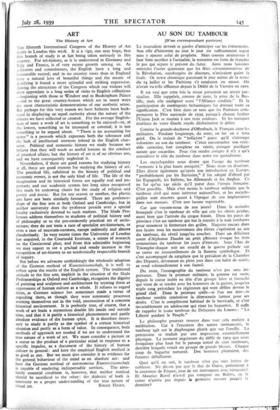ART
The History of Art
THE fifteenth International Congress of the History of Art meets in London this week. It is a rign, one may hope, that this branch of study is at last being taken seriously in this country. For art-history, as it is understood in Germany and Italy and France, is of very recent growth among us. As collectors and connoisseurs, the English have a long and honourable record; and in no country more than in England have a natural love of beautiful things and the means of gratifying it found a more splendid and striking expression. Among the attractions of the Congress which our visitors will most appreciate is a long series of visits to English collections —beginning with those at Windsor and in Buckingham Palace —and to the great country-houses which are in many ways the most characteristic demonstrations of our aesthetic sense. But perhaps for this very reason we have hitherto been back- ward in displaying an equal curiosity about the nature of the objects we have collected or created. For the average English- man of taste a work of art is something to be enjoyed—or, at the lowest, something to be treasured or coveted; it is not something to be argued about. "There is no accounting for tastes" is a proverb which expresses both the tolerance and the lack of intellectual interests inbred in the English char- acter. Political and economic history we study because we believe that they will teach us useful lessons in the conduct of practical affairs; but the history of art is of no obvious use, and we have consequently neglected it.
Nevertheless, if there are good reasons for studying history at all, theze are good reasons for studying the history of art. The practical life, exhibited in the history of political and economic events, is not the only kind of life. The life of the imagination and its historical forms are equally real and im- portant; and our academic system has long since recognised this truth by endowing chairs for the study of religion and poetry and music. But for one reason or another, the plastic. arts have not been similarly favoured. There are professor- ships of the fine arts at both Oxford and Cambridge, but in neither university does the professor preside over a special faculty exclusively devoted to such matters. The Slade Pro- fessors address themselves to students of political history and of philosophy or to the pre-eminently practical art of archi- tecture; they do not train a race of specialist art-historians, or even a race of museum-curators, except indirectly and almost clandestinely. In very recent times the University of London has acquired, in the Courtauld Institute, a centre of research on the Continental plan; and from this admirable beginning we may expect to see a gradual and steady increase in the recognition of art-history as an academically respectable branch of inquiry.
But before we advocate unthinkingly the wholesale adoption of the German method of Kunstwissenschaft, it is well to reflect upon the merits of the English system. The traditional attitude to the fine arts, implicit in the situation of the Slade Professorships at Oxford and Cambridge, recognises the dignity of painting and sculpture and architecture by treating them as expressions of human culture as a whole. It refuses to regard them, as German science has sometimes made a virtue of regarding them, as though they were automatic processes working themselves out in the void, unconscious of a concrete historical environment. It is perfectly true, of course, that a work of art leads a mysterious double life inside and outside time, and that it is partly a historical phenomenon and partly absolute evidence of the human spirit. It is therefore neces- sary to study it partly as the symbol of a certain historical situation and partly as a form of value. In consequence, both methods of approach are needed if we are to understand the true nature of a work of art. We must consider a picture or a statue as the product of a particular mind in response to a specific impulse, as a document of the history of human culture in general: and here the empirical English method is as good as any. But we must also consider it as evidence for the general behaviour of the mind as an absolute act: and here the German method of autonomous Kunstwissenschaft is capable of rendering indispensable services. The abso- lutely essential condition is, however, that neither method should be sacrificed to the other: the dialectic of both is necessary to a proper understanding of the true nature of








































 Previous page
Previous page